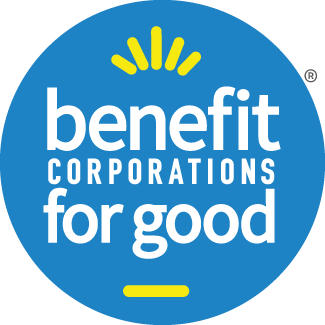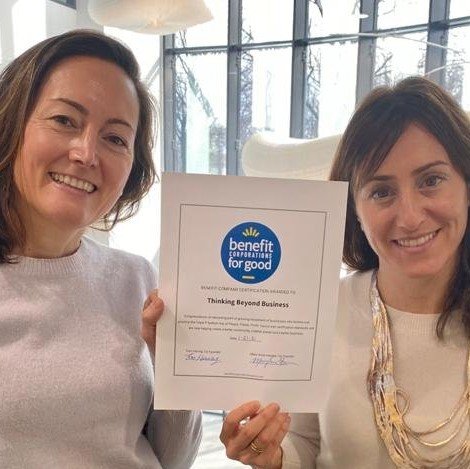Why a Women-Owned Advisory Firm Defined Its Purpose with the Triple Bottom Line
Here are Thinking Beyond Business co-founders Soledad Matteozzi and Silvina Skverer celebrating their certification as a Benefit Corporation for Good.
As a sustainability advisory firm, Thinking Beyond Business knew its mission could be summed up with 3 words: triple bottom line. The firm's leaders wanted to help entrepreneurs, small and medium-sized company leaders understand, commit, and incorporate best practices of sustainability into their business model.
Their belief is simple: with the proper mindset and the right tools, every company, no matter its size, can contribute to solving the world’s biggest problems while at the same time generating profits and new business opportunities.
We recently interviewed the Connecticut firm's co-founders, Soledad Matteozzi and Silvina Skverer, about their business becoming a certified Benefit Corporation for Good. Here’s what they had to say about it, their firm’s motivation for doing it and why they’re committed to generating positive impact in the world.
1. What motivated you to become a triple bottom line business?
Our motivation from the beginning was focused on building a purpose-driven advisory firm. We are proud to say that we are on a mission to help small and medium-sized businesses be part of the solution and help regenerate our world so our kids can enjoy a healthy planet with a thriving and inclusive society. Thinking Beyond Business (TBB) was founded with the idea of helping businesses rediscover their essence and generate positive impact while growing profitability. We are honest and approachable, and we aim to be the best sustainability advisor for small and medium-sized enterprises committed to converting their businesses models into a triple bottom line approach.
2. Was it difficult getting internal support for moving toward this model?
Our business model was conceived with a triple bottom line approach from its beginning because we firmly believe if all sectors and industries collaborate, we can build a better world. We believe that generating profit is as essential as positively impacting our world, helping businesses reduce their environmental footprint, and creating a more equitable and fair society.
3. How long did it take you to officially become a triple bottom line company?
See answer #2.
4. Have you seen any change in culture since you become a triple bottom line company?
Being a triple bottom line company is our culture. All our decisions, strategies, and initiatives are aligned with our purpose of empowering businesses to build a better world.
5. Have you experienced any positive outcomes since becoming a triple bottom line company?
From communications with our clients to reading new materials to continue our education, or assessing a business through the lenses of sustainable practices, is a positive outcome. It is a pleasure, a privilege, and pride to be working in this field, knowing that we are surrounded by committed organizations and business leaders who are dedicated to building a better world.
6. Would you recommend this business model to others? Why or why not?
For us, a triple bottom line is the only path into a sustainable future.
7. What is the most important trait to have as a conscientious leader of a triple bottom line company?
The most important trait of being a conscientious leader is knowing that we are trying and making an effort to build a better world. We don’t pretend to be perfect because perfection is the enemy of achievement. We just focus on progress. We advise our clients on walking this journey to find a meaningful purpose beyond just making profits. The result is an immense sense of achievement every time we see clients reduce their carbon emissions, have a more inclusive workforce, or see people volunteering for noble causes.
8. What lessons have you learned in the process?
We don’t want to sound like we live in La-La land. We understand that there is no mission without a profit, and that’s why in some cases, it is not simple to convert traditional business models into triple bottom-line ones. But, we are here to help our clients avoid hitting giant walls so they can focus on what is of material for them, their industries, and their particular business. Our goal is to maximize their resources to take action in the areas with the most positive impact, whether social, environmental, or economic.
9. Is being a triple bottom line company part of your current brand message?
Yes. Being a triple line company is at the core of everything we do.
10. What is the single best reason you’d give for another company or peer to become a triple bottom line company?
The feeling that you are doing what is right, with a kind and responsible approach. We believe we are at an inflection point in history. We have the chance to reinvent our world for the better, so why not be part of this movement?
You can learn more about Thinking Beyond Business here.
If you want to know more about why your business should become a benefit corporation, go here.
Learn more about the 6 simple steps to becoming a benefit corporation here.
~benefitcorporationsforgood.com~

